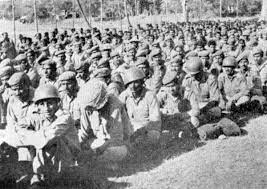
Pic Courtesy: Defence xp
The Indo-Pak war of 1971 was a defining moment in the history of the subcontinent, resulting in Bangladesh becoming independent. This established the progress of the Indian Armed Forces including the Army, Air Force and Navy. The war started on 3 December 1971, when the struggle for independence was going on in East Pakistan. The war ended 13 days later on 16 December with the surrender of the Pakistani Army (93,000 POWs).
Role of Kilo Flight in 1971 War

Pic Courtesy: Colours of glory
- Kilo Flight is the code name for the Mukti Bahini combat aviation formation during the Bangladesh Liberation War in 1971.
- It consisted of one DHC-3 Otter plane and one Alouette III helicopter.
- These ac carried rocket pods and machine guns for launching hit-and-run attacks on Pakistani targets, and one DC-3 Dakota for logistical missions.
- 9 Bengali pilots and 58 ex PAF personnel formed the unit under the command of Group Captain A. K. Khandker in September 1971.
- The aircraft were supplied by Indian Authorities and the formation was led by Squadron Leader Sultan Mahmud under the operational control of IAF base Jorhat.
- The unit started training in October 1971 at Dimapur in Nagaland, and this unit was the first to launch airstrikes on Pakistani targets in East Pakistan on December 4, 1971, by attacking oil depots at Narayanganj and Chittagong.
- In total the unit flew 90 sorties and 40 combat missions between December 4 and 16, 1971. After the war it formed the core of the nascent Bangladesh Air Force.
Breakdown of POWs of 1971 War

Pic Courtesy: Bharat Rakshak
India took approximately 93,000 prisoners of war that included Pakistani soldiers as well as some of their East Pakistani collaborators.
- 79,676 of these prisoners were uniformed personnel.
- Remaining 13,324 prisoners were civilians – either family members of the military personnel or Bihari Razarkars.
Tibetan Heroes of the 1971 War
The highly trained Special Frontier Force (SFF), played an important role along with the Mukti Bahini, in the 1971 War.
SFF was founded in November 1962. It was also known as ‘Establishment 22’ or simply ‘Two-twos’.
In 1971, the Tibetan force was selected to conduct guerrilla warfare. The terrain was a paradise for guerilla warfare. Forests and hills, rivers, streams and lakes made many areas inaccessible. Yet there was fish and fowl in abundance to keep a guerilla force functioning independently.
In February 1971, the SFF had already started infiltrating Bangladesh along with the Mukti Bahini. It was probably for reconnaissance only initialy.
The Mukti Bahini was very good at making guerrilla plans and at guerrilla tactics. SFF were responsible to support the Mukti Bahini and provide reinforcement to them as and when required.
The SFF played a crucial role in the war.
Incidentally, the force had only one helicopter. The pilot, Sqn Ldr Parvez Rustomji Jamasji, had to carry out all the duties, para-dropping over the battle sites, rations and ammunition dropping, rescue operations, etc — a feat in itself for which the young pilot was awarded Vir Chakra.
Suggestions and value additions are most welcome
For regular updates, please register here
Subscribe
References
https://www.bharat-rakshak.com/IAF/history/1971war/1403-arun-karandikar.html#gsc.tab=0
https://www.thedailystar.net/news/bangladesh/news/operation-kilo-flight-story-valour-2158326
https://en.wikipedia.org/wiki/Prisoners_of_war_during_the_Indo-Pakistani_War_of_1971



